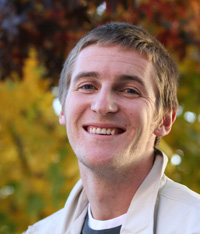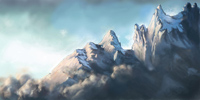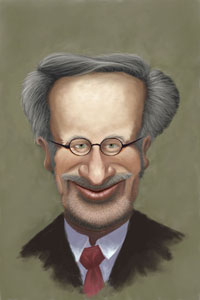Ty Carter

How did you get started with animation?
I started drawing as far back as I can remember. I did a lot of painting in high school but was a very active athlete playing soccer and basketball. That divided my time back then.
One night I was working on some high school homework when my dad started screaming at me to come upstairs. I thought I was in trouble until I got up to the family room and there he was in front of the TV.
“Have you seen this?” he asked.
There was a special on PBS featuring BYU’s new animation program. I remember just watching it all night, although I had a history test the next day.
I was intrigued and, more importantly, inspired! It was the kind of inspiration that gives you comfort. My dad was just as excited and had arranged a day to meet with Brent Adams shortly thereafter. Brent explained the program’s structure and future plans. He gave me a card with Lemmings and Lion and the Mouse (current productions of the time) images. I put it right above my desk. It’s still there today. That conversation really left a mark on me. I knew I wanted to do animation and now there was a way through BYU. I didn’t need to spend huge amounts of money on a California art school.
Brent gave me a lot of great advice that day, and he suggested taking a sketchbook everywhere I went and drawing/writing ideas in it. So, I bought a few sketch pads and took them with me on my mission. I found it impossible to sketch as a missionary but easy to jot down ideas as they came. I filled two books full of ideas jumbled with Spanish vocabulary.
When I finished my mission, I began school at BYU and was accepted into the animation program.
Why animation?
It’s an amazing medium! You can create things that are impossible. I feel like I can be a kid. Imagination has no bounds—that’s a great feeling.

What has your experience with the BYU animation program been like?
The program is incredible! I was amazed at how much I already knew when I was in the big studio. The program is well run. I think students take for granted the opportunities here at BYU sometimes. CalArt (Valencia) and Art Center (Pasadena) students made me sick when I heard their tuition costs. We are so lucky to have such an amazing faculty. They dedicate their talent to this program. They could be in the industry but choose to help others get there. That’s monumental to me. It tells you about the type of men and women they are.
Tell us about your internship at Disney.
Disney was an unforgettable experience. I worked with Bill Perkins (art director of Aladdin), Eric McLean, and Sean Kenny. They were amazing mentors. The studio is in Burbank, California. We had weekly workshops where artists like Andreas Deja (a well-known animator) taught us the do’s and don’t’s of animation. I couldn’t believe the people I was able to meet and the way they treated us. The experience is irreplaceable. It was humbling to walk in the gates each morning. Walt Disney is an inspiration to me. I couldn’t help but think about what he did to bring this medium to where it is today. He’s the reason the art form lives. This made the experience especially special to me.
Part of my internship at Disney involved coming up with future Disney concepts and ideas—stories. As interns we worked on some story ideas while we were at the studio. The plan was to come up with some ideas and pitch them to our mentors. The mentors really liked my pitch, but I never imagined they’d ask me to pitch it to John Lasseter.

In the room were big industry names—lead animators, heads of story, producers and executives. It was crazy because there I was, the intern, with these great storytelling men and women, pitching a story to them. It was a unique opportunity and humbling to be a part of Disney’s future.
One of the best parts about working on the pitch was receiving feedback from Mike Gabriel and Art Hernandez. (Mike directed Rescuers Down Under and Pocahontas. Art has a list of credits at Toon Disney as a lead story artist.) They gave me some great feedback that helped me solidify my ideas.
How do you see your work in animation and film building the kingdom?
I see animation as a great way of communicating and relating to others. What other medium communicates to so many people at one time?
Story can be a powerful teaching tool—Jesus demonstrated that. That really inspires me. There are so many ideas and stories to tell—each with its own unique potential, regardless of religious practice, to inspire someone for the better. You can take any wild idea, mesh it with truth, and if it’s told right, it changes lives.
In a similar vein, how does the gospel influence you as an animator?
It affects everything I do. When I grow, my work grows too. It all traces back to God. He’s the reason I can dream. He’s the reason I can paint. Talent, if we can call it that, is connected to God. I feel immensely grateful to live at this time when animation exists. It’s one of the greatest art forms created. It has so much potential. As Walt Disney said, “There’s already enough bad in this world, so I make good.” The gospel of Jesus Christ invites us to improve each day. It invites us to mourn with those that mourn, weep with those that weep. Art connects us to God. ❧
